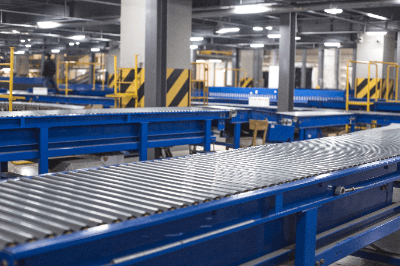What Is Transfer Machinery?
 Transfer machinery is a general term for equipment used to move goods and materials.
Transfer machinery is a general term for equipment used to move goods and materials.
Specifically, there are various types of conveyor, elevator, pipeline, rail, and self-propelled types, depending on the shape and size of the object to be conveyed and the purpose of the conveyance.
Transfer machinery may refer to a single unit, such as a conveyor, a conveyor system integrated into a production system, or a conveyor system integrated into a logistics system, such as a warehouse, factory, or distribution system.
Transfer machinery is generally handled in the factory automation (FA) industry. In many cases, we offer not only single units but also optimal conveying systems for the objects to be conveyed, their contents, installation conditions, and so on.
Uses of Transfer Machinery
Transfer machinery is used to move goods and materials in distribution warehouses for the transportation industry, inventory control warehouses for the mail-order industry, warehouses that handle pickup, packaging, and shipping, production plants, and processing facilities. Movement includes horizontal, elevated, inverted, rotary, and fluidized movement, and conveyor units are used for each of these applications.
If the purpose cannot be achieved by the conveyor unit alone, they are combined and used in a system that performs the desired conveyance.
Principle of Transfer Machinery
1. Conveyor Transport
Conveyor units are available in belt, chain, and roller types. In the belt or chain type, the belt or chain is stretched around a certain section of the conveyor. In the roller type, rollers are placed at regular intervals over a certain section.
The belt, chain, or rollers are then rotated by a motor. By placing the object to be conveyed on the belt, chain, or rollers, the object is moved parallel to the belt, chain, or rollers.
2. Rail Transport
In the case of rail conveyance, rails are installed in the conveyance section. A container equipped with a drive unit is installed on the rail, and the container is driven while the object to be transported is placed inside the container.
3. Inverted Conveyance
In conveyance, it is sometimes necessary to invert the object to be conveyed in order to align the direction of the object. For example, bottles that are lying on their sides may need to be placed upright and their contents placed inside.
In such cases, a mechanism is needed to convey the object while inverting it.
4. Rotary Conveyance
In conveyance, there are cases where it is necessary to rotate the object to be conveyed in order to align the direction of the object. For example, labels on boxes flowing in an indeterminate direction may need to be aligned.
In such cases, a system that rotates the object to be conveyed is required.
5. Lifting and Lowering Conveyance
In some cases, conveyance may require moving an object up and down. For example, the object may need to be moved up and down from the height of a shelf to the height of a conveyor.
In such cases, a mechanism to raise or lower the object to be transferred by machinery is required, and equipment, such as a lifter or elevator, is used.
6. Pipeline Conveying
In some cases, powder or granular materials are conveyed. For example, food flour or pellets of plastic material are moved in an unpacked state.
In such cases, a pipeline is installed in the conveyance section and gravity or air pressure is used to move the material through the pipeline.
7. Self-Propelled Conveyance
Transfer machinery includes self-propelled automatic guided vehicles (AGVs), which can be programmed to travel along any route and do not require any transfer equipment along the route.
Therefore, AGVs are used in outdoor locations where it is difficult to set up Transfer Machinery.
Other Information on Transfer Machinery
Difference From Logistics
Although you may see articles that refer to transfer machinery as “logistics,” in reality, transfer machinery and logistics are two different things. Logistics is the centralized management of the entire flow of goods, including procurement, distribution, processing, and shipping.
In contrast, transportation may be a part of that process, but it does not cover the entire scope of the process.